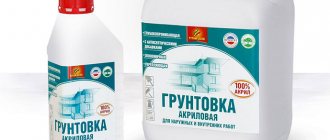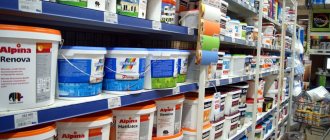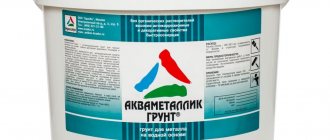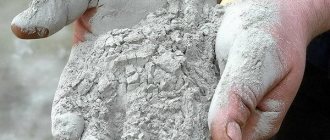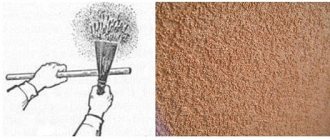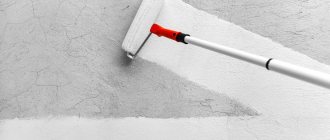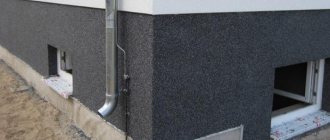Why do you need a primer for a concrete floor?
Figure 1. Primer mixture for concrete floors
Primer mixture for floors made of various grades of concrete is used to ensure:
- filling unevenness, roughness, small pores in concrete;
- creating a level base before applying the finishing leveling solution, as well as gluing the main floor covering;
- more reliable connection between the base and the floor covering.
- protection of the base from rapid destruction under the influence of moisture, from mechanical loads and damage.
Advantages and disadvantages
Like any building material, primer mixtures have certain pros and cons. Their advantages are as follows:
- have good adhesion to the base;
- have a high rate of spreadability over the main surface;
- form a durable, reliable, even coating;
- retain their technical properties under temperature changes;
- no sophisticated equipment is required (to prime a concrete floor, a small roller, a regular hand sprayer or a wide brush is enough)
The disadvantages of primers are their following features:
- certain types of soil contain substances that pose a potential danger to the environment and human health;
- long period of hardening of the primer layer.
Features of application
When arranging floors, the primer is used to treat screeds, cement and concrete bases, stone and ceramic coatings, wood, and before using a self-leveling mixture.
Most protect against mold, rust and salt stains. You can buy primers that have special properties:
- Water-repellent abilities;
- For arranging heated floors;
- Electrically conductive.
Important! It is recommended to purchase materials from one manufacturer (primers, glue, putties). Otherwise they may not be compatible.
- A correctly selected and applied primer technology will improve the quality of the finish and maintain the integrity of the layers.
- To work with mineral substrates (plaster, brick, gypsum, concrete), general construction primers can be used.
- Highly specialized primers have an improved formulation and are designed for a specific type of base. Their use gives maximum effect.
- The consumption of the primer mixture may vary depending on the material: on average 100-300 grams, but it should only be applied to a dry surface or base with a minimum level of humidity (according to SNiP).
Types of primer for concrete floors
Based on their properties and scope of application, primer mixtures are divided into the following types:
- filling - applied to floors with a large number of small pores capable of absorbing moisture;
- adhesive (film-forming) - such compositions are used for priming relatively dense and non-moisture-absorbing substrates. By forming a continuous film of uniform thickness, they improve the adhesion of the finishing coating to the concrete screed.
- strengthening - compounds that, by filling the pores in the concrete base and covering it with a continuous film, increase its strength and resistance to mechanical loads;
- penetrating (deep penetration primers) - compositions that are used on dusty concrete floors. Due to their high penetrating ability, they are able to fill the deep pores of the base, thereby giving it additional strength and extending its service life.
According to the chemical composition, primer mixtures are alkyd, acrylic, epoxy, and polystyrene. Alkyd.
They contain alkyd polymers. The technical characteristics of such a primer mixture are as follows:
- retains properties in the temperature range from – 30. C to + 50 0 C;
- not afraid of exposure to aggressive environments (acids, alkalis);
- forms a durable surface that is resistant to abrasion.
Figure 2. Alkyd primer for concrete floors
Acrylic
It contains water and acrylic compounds. The main advantages of acrylic primer for concrete floors are its following features:
- reduces water absorption by porous substrates;
- provides good spreadability for subsequent application of leveling compounds (self-leveling or simple sand-cement screeds);
- after application to the surface it hardens quickly (3-4 hours);
- not afraid of the effects of alkali, high humidity;
- does not contain solvents, environmentally friendly.
Figure 3. Acrylic primer
The primer is not recommended for use in rooms with high humidity. The most popular acrylic primer is considered to be such a special composition as “Betonkontakt”.
Epoxy
The basis of this primer is epoxy resin and hardeners. The advantages of epoxy primer over analogues are as follows:
- retains properties at zero and negative temperature changes;
- creates additional protection of the base from mechanical damage;
- interacts perfectly with the final paint coating.
Figure 4. Epoxy primer for concrete
This material also has a drawback: a one-component epoxy primer for a concrete floor may not contain hardeners, which is why it will take time (more than 12 hours) for the layer to dry. The process of arranging the floor will have to be paused a little and wait. When choosing an epoxy primer for a concrete floor, these points should be taken into account.
Polystyrene
This primer mixture contains highly toxic solvents. It is used mainly for processing wooden bases of open buildings (terraces, gazebos). For concrete floors, this type of soil is used very rarely.
Other types of soils
Among other types of this material, the most common are the following primers:
- polyurethane - the most common primer mixture for concrete floors under paint and varnish;
- perchlorovinyl - the chemical composition of this soil contains many toxic components, so its scope is limited;
- a mineral mixture consisting of cement, lime, gypsum, used for priming concrete.
The feasibility of priming the screed
The primer under the screed will bind small particles, create a film, and improve adhesion. The quality of the screed arrangement is no less important than the correct installation of the finished floor. The requirements for both can be read in SNiP (a set of standards and recommendations). Applying a primer to the floor after screeding is one of the points in the standard installation technology. Compliance with it will ensure:
- Increased contact area and maximum adhesion of the screed to the surface.
- Formation of a water-repellent effect, which is created by special compositions for primers. They form a thin film. As a result, there is no need for an additional layer of waterproofing.
- Strengthens the base and minimizes its absorbency.
Important! Primer before screed is as necessary as treating the floor with primer after it. The fact is that no matter how carefully you remove dust from the surface, it is not possible to completely get rid of it. The primer under the screed will bind small particles, create a film and, of course, improve adhesion.
The choice of primer directly depends on the type and condition of the surfaces.
How to choose a primer for a concrete floor
The solution for concrete floors must ensure, first of all, their strengthening and leveling. Since concrete does not have a high degree of adhesion, the soil applied to the surface of the concrete base ensures its strong adhesion to the floor covering. These are general points to consider when choosing soils. There are also specific situations, for example, where and under what conditions the floor will be used, what kind of finishing coating.
The properties of adhesive (film-forming) strengthening primers make it possible to fully cope with such tasks.
To choose the right primer for a concrete floor with the most suitable properties and composition, we focus on the absorbency of the base. The surface of concrete floors is characterized by a low degree of absorption. Drops of water applied to concrete remain on the floor surface for 15-20 minutes.
Conclusion
Priming the screed and the base underneath is an important part of the work, which ensures maximum reliability of the floor and prevents dust formation. The video in this article will help you understand the topic even better, and if you have questions or encountered unexpected difficulties while performing the work, then write in the comments under the review, we will sort out all the nuances together.
Did you like the article? Subscribe to our Yandex.Zen channel
November 1, 2021
Pouring and screeding floors, Construction Chemicals
If you want to express gratitude, add a clarification or objection, or ask the author something, add a comment or say thank you!
Composition and properties of primer for concrete floors
Primers for concrete are based on acrylic, polyurethane, epoxy components, quartz sand, and cement.
The main properties that all primers for concrete floors have are the following:
- uniform distribution over the surface of the concrete floor;
- high film strength of the primer mixture, comparable to that of the concrete base on which it is applied;
- durability of the primer layer - when applied correctly, the primer layer does not collapse and does not lose its performance properties for 50-80 years.
Tool selection
One of the most important actions when facing with soil is the equal distribution of material over the surface. Thanks to the stiff brush, the screed spreads sand and dust, making the surface smooth.
You can also use a roller as a means of applying the material. In this case, there are small shortcomings when the work is completed. The appearance of bubbles from oxygen is not a very pleasant moment, since they can then damage potholes and pits in place. In order to prevent this, you need to remove the bubbles on the spot with a needle.
Used for surface treatment:
- putty knife;
- roller;
- mixer.
A bucket is also useful for normal and fruitful work. It's great for kneading. Another tool that will speed up the work process is a special mixer for mixing. Since most hardware stores sell concentrated products, they must be mixed with water. A mixer is the best assistant in this matter.
How and with what to apply primer to a concrete floor?
A layer of primer is applied to a clean, dry floor surface. The debris is removed, small cracks are puttied, oily areas are degreased. The solution is prepared strictly according to the instructions in compliance with the proportions indicated on the label. To apply the composition, use a special roller, brush, or spray bottle.
Important. When applying floor primer, be sure to wear a respirator, safety glasses, and gloves - the components contained in the composition pose a potential danger to the human body. When using epoxy primers that are diluted with organic solvents (acetone, white spirit), the room must have good natural or artificial ventilation.
Application rules
There are 2 types of primers sold in stores - ready-to-use, and dry mixtures, which must be prepared in accordance with the instructions. Typically, dry compositions are diluted with ordinary water; it is important to dilute them exactly according to the instructions, since a large amount of water can disrupt the technical characteristics of the composition. If too little water is used for dilution, the applied primer layer may peel off, causing you to have to re-prime.
Before you begin priming a concrete floor, you need to make sure that the temperature and humidity correspond to those recommended by the primer manufacturer. If the air humidity is too high, the primer composition may foam, making it unsuitable for use. The mixture cannot be applied to the base at subzero air and base temperatures, as the characteristics of the composition will be significantly deteriorated. This does not apply to frost-resistant soils.
The process of applying the mixture must be carried out either using a spray gun or using a roller. To treat hard-to-reach places, you need to use a brush. For maximum protection, it is recommended to apply the primer solution in two layers, especially if the surface density is low. The second layer can be applied to the base only when the first layer has completely dried.
The amount of primer used on a concrete floor depends on its porosity and moisture absorption capacity. If there are loose and damaged areas of the base, then the mixture must be applied until it stops being absorbed. As a result, a surface film should appear, which will indicate that the problem area is well saturated.


